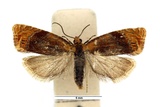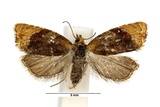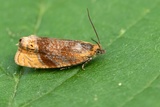Eucosmomorpha albersana (Hübner, [1813]) Species
Last modified: Nov. 23, 2025, 5:29 p.m.
A very rare species in Belgium.
Details
- Classification
- Family: Tortricidae > Subfamily: Olethreutinae > Tribus: Enarmoniini > Genus: Eucosmomorpha > Species: Eucosmomorpha albersana
- Vernacular names
- Roetvlekbladroller (NL), Honeysuckle Bell (EN), Schneebeerenwickler (DE)
- First mention in Belgium
- De Fré Ch. 1858. Catalogue des Microlépidoptères de la Belgique. — Annales de la Société entomologique belge 2: 45–162. On page 86.
- Status
-
Native
Distribution
Imago
Wingspan 13–15 mm. A small but attractive species. Distinguished by the sharply demarcated dark brown basal two-thirds of the forewing, which is divided by a silvery metallic stria running from the tornus to the costa and contrasting with the orange-ochreous distal part of the wing.
Caterpillar
The caterpillar is yellowish-white, the head is light brown, the neck and anal shields differ little from the body color, the neck shield has a larger dot on each side and a small black dot behind it.
Bionomics
The larva feeds in August and September between spun leaves on the host plant. It hibernates in a cocoon spun in the larval habitaition or amongst leaf-litter. Pupation takes places in that cocoon.
They fly actively in afternoon sunshine and can be observed resting on the foliage of the foodplant. Later they occasionally come to light.
Flight periods
The adults fly in May and June.
Observed on
- Host plant (genera):
- Lonicera and Symphoricarpos
The larva feeds on Lonicera and Symphoricarpus alba.
Habitat
It inhabits woods and clearings.






